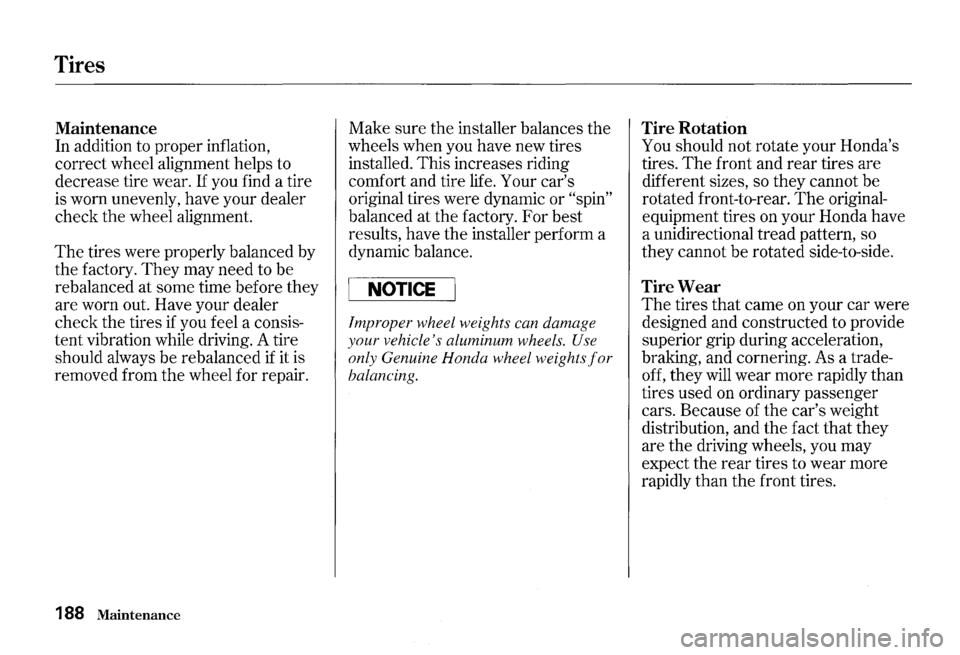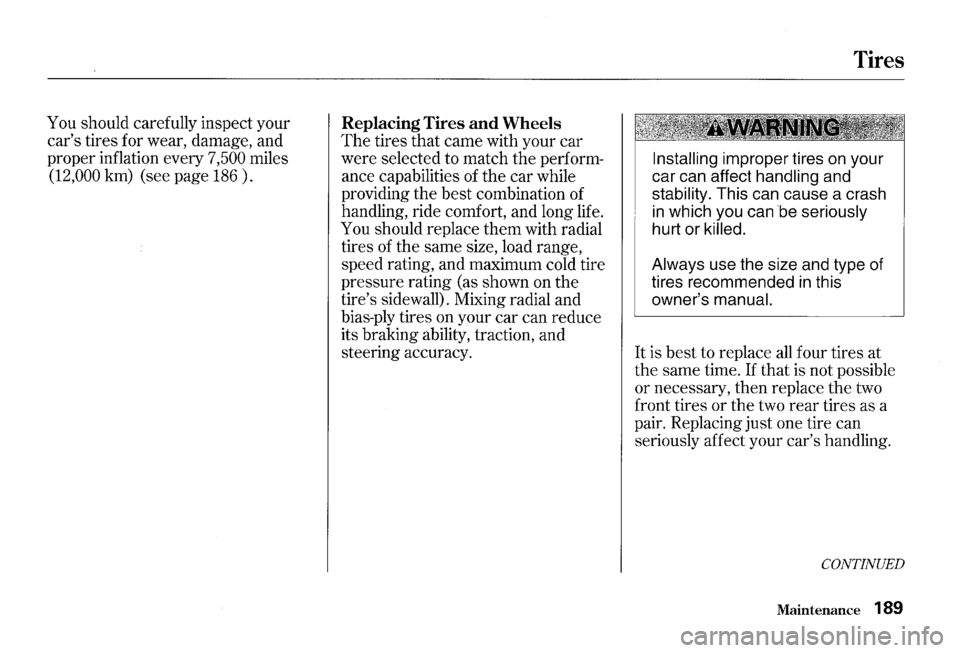2000 HONDA S2000 wheel
[x] Cancel search: wheelPage 143 of 273

Driving in Bad Weather
Rain, fog, and snow conditions re
quire a different driving technique
because of reduced traction and
visibility. Keep your car well
maintained and exercise greater
caution when you need to drive in
bad weather.
The cruise control
should not be used in these condi
tions.
140 Driving
Driving Technique -Always drive
slower than you would
in dry
weather.
It takes your car longer to
react, even
in conditions that may
seem just barely damp. Apply
smooth, even pressure to
all the
controls. Abrupt steering wheel
movements or sudden, hard appli
cation of the brakes can cause loss of
control in wet weather. Be extra
cautious for the first few miles
(kilometers) of driving while you
adjust to the change in driving
conditions.
This is especially true in
snow. A person can forget some
snow-driving techniques during the
summer months.
Practice is needed
to relearn those skills.
Exercise extra caution when driving
in rain after a long dry spell. After
months of dry weather, the first
rains bring
oil to the surface of the
roadway, making it slippery.
Visibility -Being able to see
clearly in
all directions and being
visible to other drivers are important
in all weather conditions. This is
more difficult
in bad weather. To be
seen more clearly during daylight
hours, turn on your headlights.
Inspect your windshield wipers and
washers frequently. Keep the wind
shield washer reservoir full of the
proper fluid. Have the windshield
wiper blades replaced
if they start to
streak the windshield or leave parts
unwiped.
Use the defrosters and air
conditioning to keep the windows
from fogging up on
the inside (see
page
91 ).
Page 144 of 273

Traction -Check your tires
frequently for wear and proper
pressure. Both are important
in
preventing "hydroplaning" (loss of
traction on a wet surface). In the
winter, mount snow tires on all four
wheels for the
best handling.
Watch road conditions carefully,
they can change from moment to
moment. Wet leaves can be as
slip
pery as ice. "Clear" roads can have
patches of ice. Driving conditions
can be very hazardous when the
outside temperature is near freezing.
The road surface can become
covered with areas of water puddles
mixed with areas of ice, so your
traction can change without warning.
Be careful when downshifting. If
traction is low, you can lock up the
drive wheels for a moment and cause
a skid.
Driving in Bad Weather, Towing a Trailer
Be very cautious when passing, or
being passed by other cars.
The
spray from large cars reduces your
visibility, and the wind buffeting can
cause you to lose control.
Towing a Trailer
Your car is not designed to tow a
trailer. Attempting to
do so can void
your warranties.
Driving 141
Page 146 of 273

This section explains why it is
important to keep your car well
maintained and to follow basic
maintenance safety precautions.
This section also includes
Maintenance Schedules for normal
driving and severe driving conditions,
a Maintenance Record, and instruc
tions for simple maintenance tasks
you may want to take care of
yourself.
If you have the skills and tools to per
form more complex maintenance
tasks on your Honda, you may want
to purchase
the Service Manual. See
page 259 for information on how to
obtain a copy,
or see your Honda
dealer. Maintenance
Safety .......................
144
Important
Safety Precautions .. 145
Maintenance Schedule .................. 146
Required Maintenance Record
.... 153
Owner Maintenance Checks ........ 155
Fluid Locations ............................... 156
Engine Oil ....................................... 157
Adding Oil... ................................ 157
Recommended Oil ..................... 157
Synthetic
Oil ............................... 158
Additives ..................................... 158
Changing the Oil and Filter.. .... 159
Cooling System .............................. 161
Adding Engine Coolant ............. 161
Replacing Engine Coolant ........ 163
Windshield Washers ..................... 167
6-speed Manual Transmission
Fluid ............................................
168
Differential Fluid ........................... 169
Brake and Clutch Fluid ................. 170
Brake Fluid ................................. 170
Brake System ............................. 170
Clutch System ............................ 171
Air Cleaner Element.. .................... 172
Hood Latch ..................................... 174
Maintenance
Spark Plugs ..................................... 174
Replacement ............................... 17 4
Specifications ............................. 176
Battery ............................................
177
Wiper Blades .................................. 180
Air Conditioning System ............... 182
Air Conditioning Filter, ................. 183
Drive Belt ........................................ 184
Tires ................................................ 185
Inflation ....................................... 185
Inspection ................................... 187
Maintenance ............................... 188
Tire Rotation .............................. 188
Tire Wear .................................... 188
Replacing Tires and Wheels .... 189
Wheels and Tires ....................... 190
Winter Driving ........................... 190
Snow
Tires .............................. 191
Tire Chains ............................. 191
Lights .............................................. 192
Replacing Bulbs ......................... 194
Storing Your Car ............................ 202
Maintenance 143
Page 191 of 273

Tires
Maintenance
In addition to proper inflation,
correct wheel alignment helps to
decrease tire wear.
If you find a tire
is worn unevenly, have your dealer
check the wheel alignment.
The tires were properly balanced by
the factory.
They may need to be
rebalanced at some time before they
are worn out. Have your dealer
check the tires
if you feel a consis
tent vibration while driving. A tire
should always be rebalanced if it is
removed from
the wheel for repair.
188 Maintenance
Make sure the installer balances the
wheels when you have new tires
installed. This increases riding
comfort and tire life.
Your car's
original tires were dynamic or
"spin"
balanced at the factory. For best
results, have the installer perform a
dynamic balance.
NOTICE
Improper wheel weights can damage
your vehicle's aluminum wheels.
Use
only Genuine Honda wheel weights for
balancing.
Tire Rotation
You should not rotate your Honda's
tires.
The front and rear tires are
different sizes, so they cannot be
rotated front-to-rear.
The original
equipment tires on your Honda have
a unidirectional tread pattern, so
they cannot be rotated side-to-side.
Tire Wear
The tires that came on your car were
designed and constructed to provide
superior grip during acceleration,
braking, and cornering. As a trade
off, they
will wear more rapidly than
tires used on ordinary passenger
cars. Because of the car's weight
distribution, and the fact that they
are the driving wheels, you may
expect the
rear tires to wear more
rapidly than the front tires.
Page 192 of 273

You should carefully inspect your
car's tires for wear, damage, and
proper inflation every
7,500 miles
(12,000 km) (see page 186 ) .
Replacing Tires and Wheels
The tires that came with your car
were selected to match the perform
ance capabilities of the car while
providing the best combination of
handling, ride comfort, and long life.
You should replace them with radial
tires of the same size, load range,
speed rating, and maximum cold tire
pressure rating (as shown on the
tire's sidewall). Mixing radial and
bias-ply tires on your car can reduce
its braking ability, traction, and
steering accuracy.
Tires
Installing improper tires on your
car can affect
handling and
stability. This can cause a crash
in which you can be seriously
hurt or killed.
Always
use the size and type of
tires recommended
in this
owner's
manual.
It is best to replace all four tires at
the same time. If that is not possible
or necessary, then replace the two
front tires or the two
rear tires as a
pair. Replacing just one tire can
seriously affect your car's handling.
CONTINUED
Maintenance 189
Page 193 of 273

Tires
The ABS works by comparing the
speed of the wheels. When replacing
tires, use the same size originally
supplied with the car. Tire size and
construction can affect wheel speed
and may cause the system to work
in
consistently.
If you ever need to replace a wheel,
make sure the wheel's specifications
match those of the original wheel
that came on your car. Replacement
wheels are available at your Honda
dealer.
190 Maintenance
Wheels and Tires
Wheels:
Front:
16x61/2JJ
Rear:
16x71/2JJ
Tires: Front:
205/55R16 89W
Rear:
225/50R16 92W
See page 246 for information about
DOT Tire Quality Grading.
Winter Driving
Tires that are marked "M + S" on the
sidewall have an all-weather tread
design.
They should be suitable for
most winter driving conditions. Tires
without these markings are designed
for optimum traction in dry
conditions.
They may not provide
adequate performance in winter
driving.
For the best performance in snowy
or icy conditions, you should install
snow tires or tire chains.
They may
be required by local laws under
certain conditions.
Page 194 of 273

Snow Tires
If you mount snow tires on your
Honda, make sure they are radial
tires of the same size and load range
as
the original tires. Mount snow
tires on
all four wheels to balance
your vehicle's handling in all weather
conditions. Keep
in mind the traction
provided by snow tires on dry roads
may not be as high as your vehicle's
original equipment tires. You should
drive cautiously even when the roads
are clear. Check with the tire dealer
for maximum speed recommenda
tions.
Tire Chains
Because your Honda has limited tire
clearance, mount only
SAE Class "S"
cable-type traction devices on the
rear tires.
Use traction devices only
when required by driving conditions
or local laws. Make sure they are the
correct size for your tires.
Metal link-type
"chains" should not
be used.
No matter how tight they
seem to be installed, they can come
into contact with the body and
suspension, causing serious damage.
When installing
the cables, follow
the manufacturer's instructions and
mount
them as tightly as you can.
Drive slowly with them installed.
If
you hear them coming in contact
with the body or chassis, stop and
investigate. Make sure the cables are
installed tightly, and
that they are
not contacting the brake lines
or
suspension. Remove them as soon as
you start driving on cleared roads.
Tires
NOTICE
Cables that are the wrong size or
improperly installed can damage your ·
car's brake lines, suspension, body, and
wheels. Stop driving (l they are hitting
any part
of the car.
Maintenance 191
Page 199 of 273

Lights
Replacing Front Tum Signal and
Side Marker Light Bulbs
1. If you are changing the bulb on
the driver's side, start the engine,
turn the steering wheel
all the way
to the right, and turn off the
engine.
If you are changing the
bulb on the passenger's side, turn
the steering wheel to the left.
196 Maintenance
2. Use a flat-tipped screwdriver to
remove the three holding clips
from the inner fender.
3. Pull the inner fender cover back.
4. Remove the socket from the
headlight assembly by turning it
one-quarter turn counterclockwise.
5. Pull the bulb straight out of its
socket.
6. Install the new bulb in the socket.
7. Insert the socket back into the
headlight assembly.
Turn it
clockwise to lock it
in place.
8. Test the lights to make sure the
new bulb is working.
9. Put the inner fender in place.
Install the two holding clips. Lock
each clip in place by pushing on
the center.